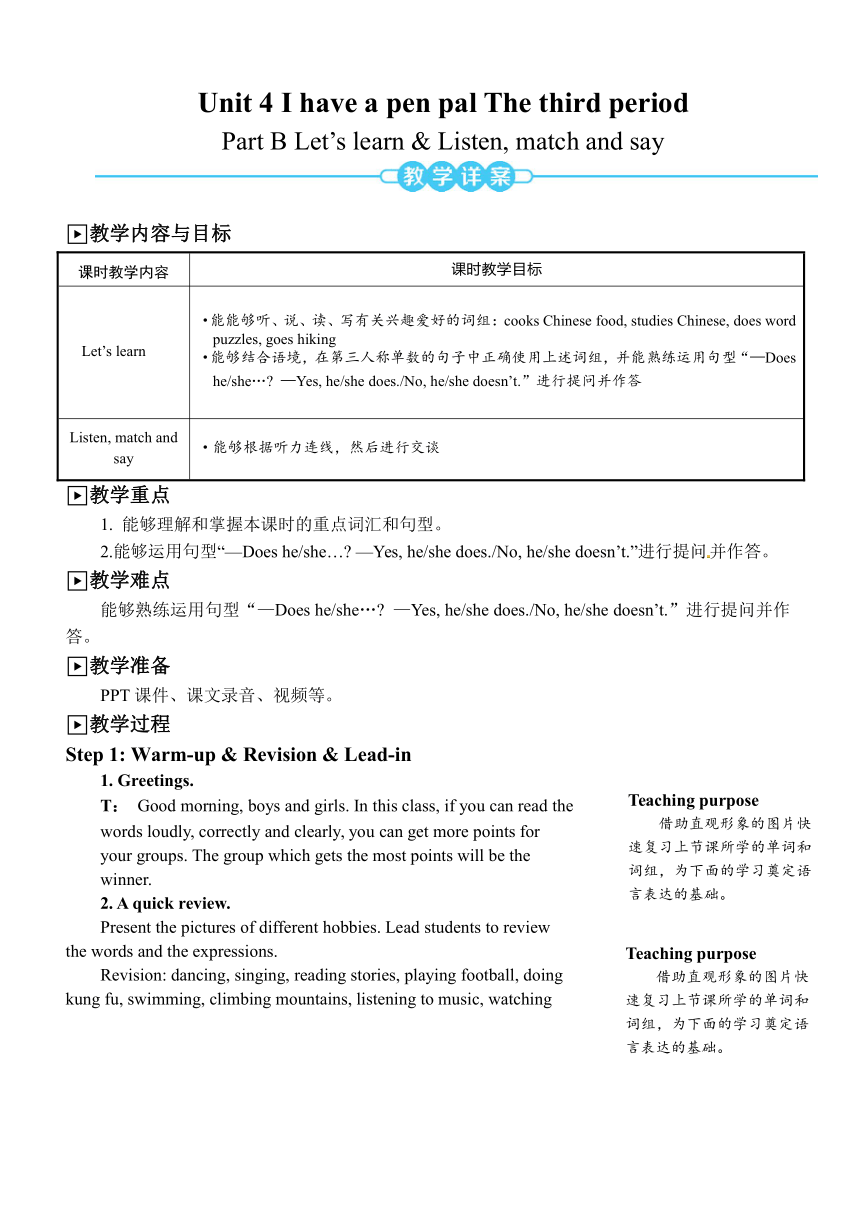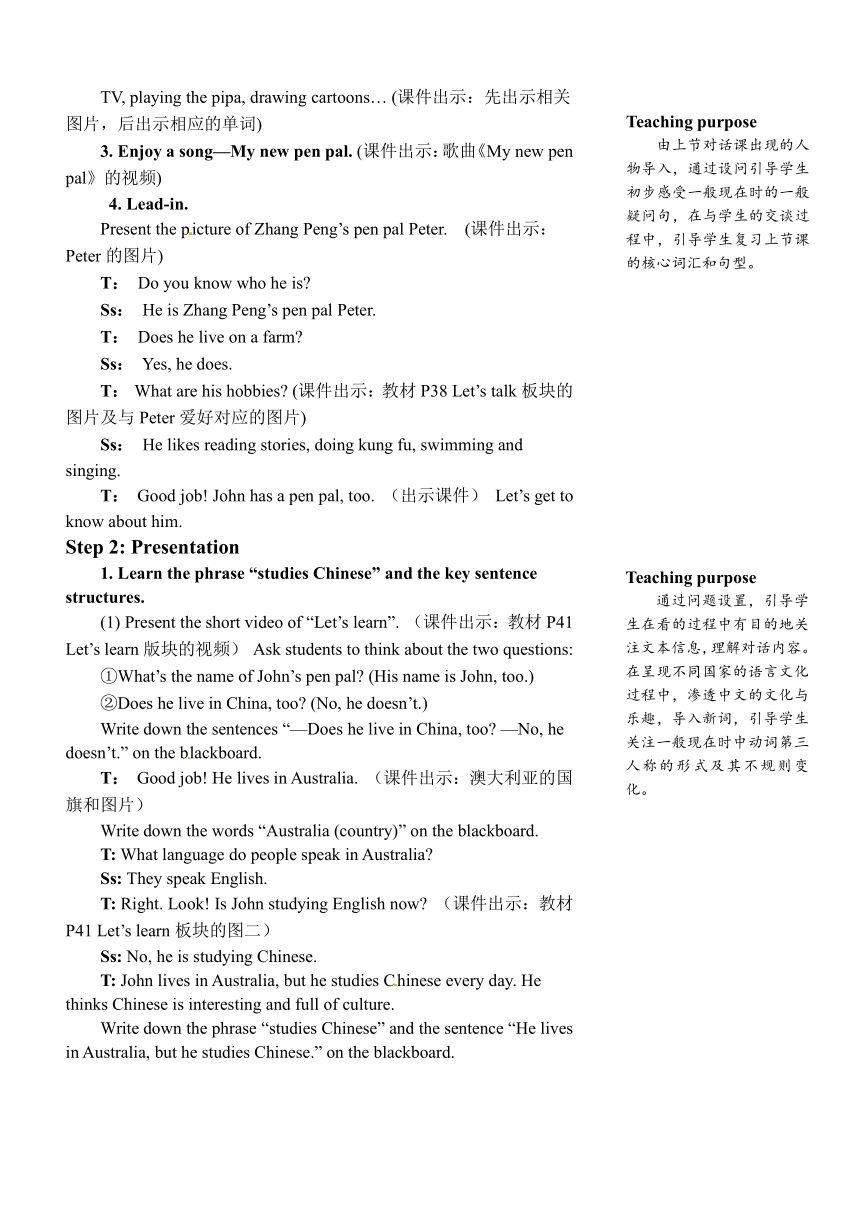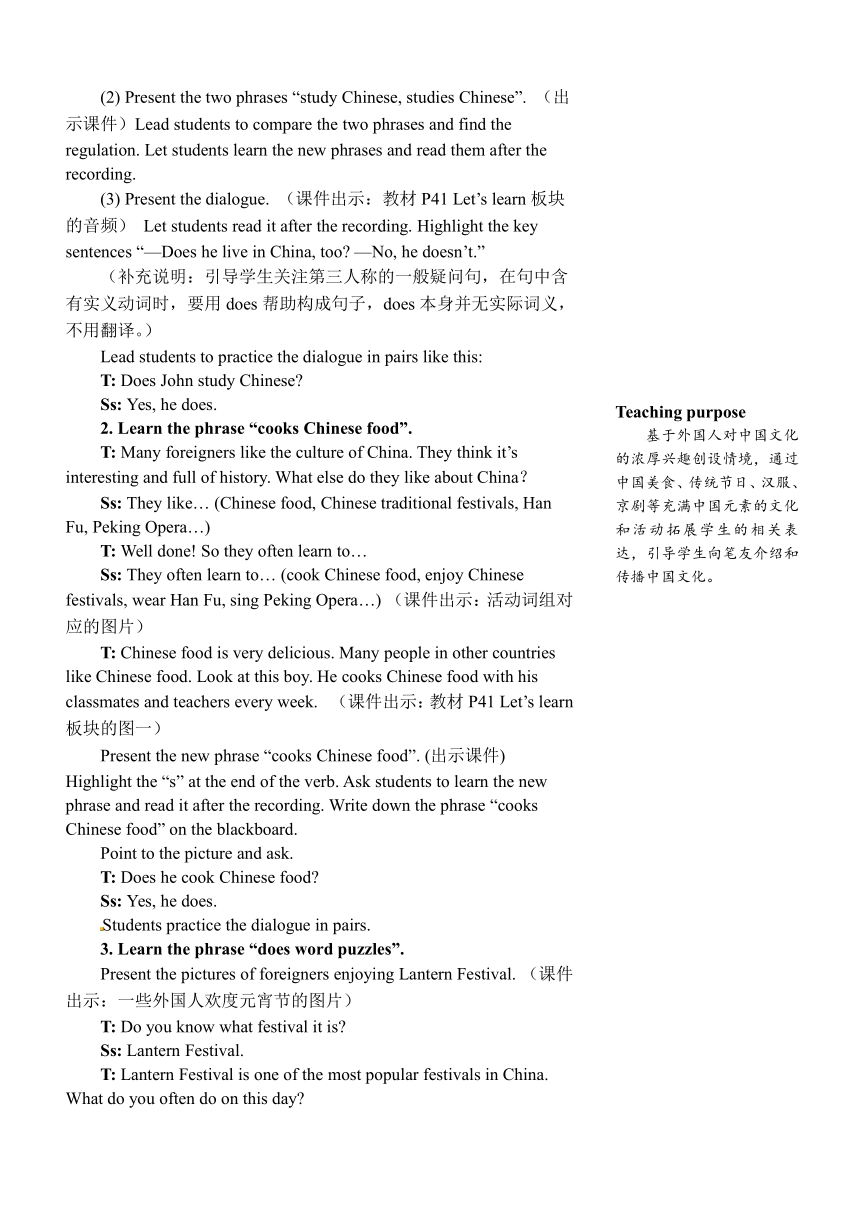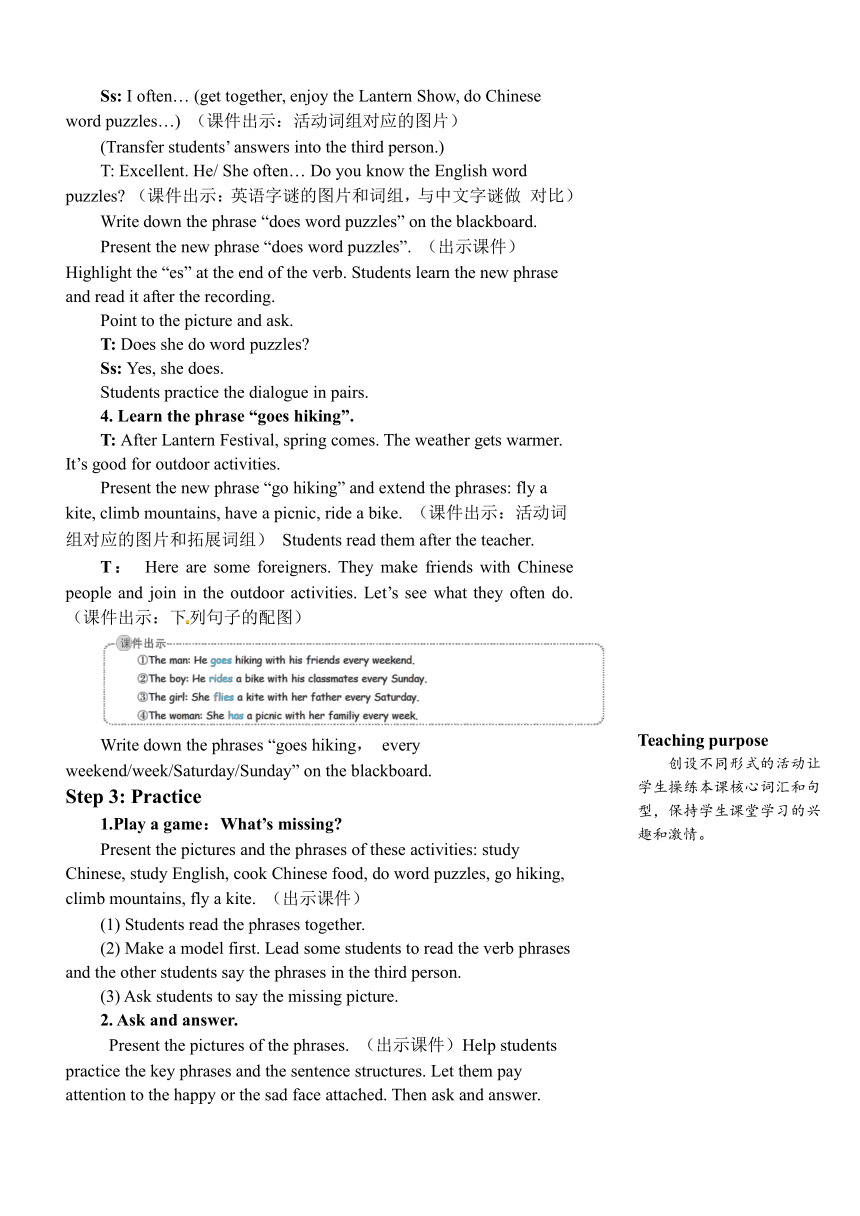Unit 4 I have a pen pal Part B Let’s learn 教案(含反思,详案与简案)
文档属性
| 名称 | Unit 4 I have a pen pal Part B Let’s learn 教案(含反思,详案与简案) |  | |
| 格式 | zip | ||
| 文件大小 | 163.0KB | ||
| 资源类型 | 教案 | ||
| 版本资源 | 人教版(PEP) | ||
| 科目 | 英语 | ||
| 更新时间 | 2020-06-12 14:39:16 | ||
图片预览




文档简介
Unit
4
I
have
a
pen
pal
The
third
period
Part
B
Let’s
learn
&
Listen,
match
and
say
?教学内容与目标
课时教学内容
课时教学目标
Let’s
learn[来源:学_科_网]
·能能够听、说、读、写有关兴趣爱好的词组:cooks
Chinese
food,
studies
Chinese,
does
word
puzzles,
goes
hiking·能够结合语境,在第三人称单数的句子中正确使用上述词组,并能熟练运用句型“—Does
he/she…?
—Yes,
he/she
does./No,
he/she
doesn’t.”进行提问并作答
Listen,
match
and
say
·能够根据听力连线,然后进行交谈
?教学重点
1.
能够理解和掌握本课时的重点词汇和句型。
2.能够运用句型“—Does
he/she…?
—Yes,
he/she
does./No,
he/she
doesn’t.”进行提问并作答。
?教学难点
能够熟练运用句型“—Does
he/she…?
—Yes,
he/she
does./No,
he/she
doesn’t.”进行提问并作答。
?教学准备
PPT课件、课文录音、视频等。
?教学过程
Step
1:
Warm-up
&
Revision
&
Lead-in
1.
Greetings.
T:
Good
morning,
boys
and
girls.
In
this
class,
if
you
can
read
the
words
loudly,
correctly
and
clearly,
you
can
get
more
points
for
your
groups.
The
group
which
gets
the
most
points
will
be
the
winner.
2.
A
quick
review.
Present
the
pictures
of
different
hobbies.
Lead
students
to
review
the
words
and
the
expressions.
Revision:
dancing,
singing,
reading
stories,
playing
football,
doing
kung
fu,
swimming,
climbing
mountains,
listening
to
music,
watching
TV,
playing
the
pipa,
drawing
cartoons…
(课件出示:先出示相关图片,后出示相应的单词)
3.
Enjoy
a
song—My
new
pen
pal.
(课件出示:歌曲《My
new
pen
pal》的视频)
4.
Lead-in.
Present
the
picture
of
Zhang
Peng’s
pen
pal
Peter.
(课件出示:Peter的图片)
T:
Do
you
know
who
he
is?
Ss:
He
is
Zhang
Peng’s
pen
pal
Peter.
T:
Does
he
live
on
a
farm?
Ss:
Yes,
he
does.
T:
What
are
his
hobbies?
(课件出示:教材P38
Let’s
talk板块的图片及与Peter爱好对应的图片)
Ss:
He
likes
reading
stories,
doing
kung
fu,
swimming
and
singing.
T:
Good
job!
John
has
a
pen
pal,
too.
(出示课件)
Let’s
get
to
know
about
him.
Step
2:
Presentation
1.
Learn
the
phrase
“studies
Chinese”
and
the
key
sentence
structures.
(1)
Present
the
short
video
of
“Let’s
learn”.
(课件出示:教材P41
Let’s
learn版块的视频)
Ask
students
to
think
about
the
two
questions:
①What’s
the
name
of
John’s
pen
pal?
(His
name
is
John,
too.)
②Does
he
live
in
China,
too?
(No,
he
doesn’t.)
Write
down
the
sentences
“—Does
he
live
in
China,
too?
—No,
he
doesn’t.”
on
the
blackboard.
T:
Good
job!
He
lives
in
Australia.
(课件出示:澳大利亚的国旗和图片)
Write
down
the
words
“Australia
(country)”
on
the
blackboard.
T:
What
language
do
people
speak
in
Australia?
Ss:
They
speak
English.
T:
Right.
Look!
Is
John
studying
English
now?
(课件出示:教材P41
Let’s
learn板块的图二)
Ss:
No,
he
is
studying
Chinese.
T:
John
lives
in
Australia,
but
he
studies
Chinese
every
day.
He
thinks
Chinese
is
interesting
and
full
of
culture.
Write
down
the
phrase
“studies
Chinese”
and
the
sentence
“He
lives
in
Australia,
but
he
studies
Chinese.”
on
the
blackboard.
(2)
Present
the
two
phrases
“study
Chinese,
studies
Chinese”.
(出示课件)Lead
students
to
compare
the
two
phrases
and
find
the
regulation.
Let
students
learn
the
new
phrases
and
read
them
after
the
recording.
(3)
Present
the
dialogue.
(课件出示:教材P41
Let’s
learn板块的音频)
Let
students
read
it
after
the
recording.
Highlight
the
key
sentences
“—Does
he
live
in
China,
too?
—No,
he
doesn’t.”
(补充说明:引导学生关注第三人称的一般疑问句,在句中含有实义动词时,要用does帮助构成句子,does本身并无实际词义,不用翻译。)
Lead
students
to
practice
the
dialogue
in
pairs
like
this:
T:
Does
John
study
Chinese?
Ss:
Yes,
he
does.
2.
Learn
the
phrase
“cooks
Chinese
food”.
T:
Many
foreigners
like
the
culture
of
China.
They
think
it’s
interesting
and
full
of
history.
What
else
do
they
like
about
China?
Ss:
They
like…
(Chinese
food,
Chinese
traditional
festivals,
Han
Fu,
Peking
Opera…)
T:
Well
done!
So
they
often
learn
to…
Ss:
They
often
learn
to…
(cook
Chinese
food,
enjoy
Chinese
festivals,
wear
Han
Fu,
sing
Peking
Opera…)
(课件出示:活动词组对应的图片)
T:
Chinese
food
is
very
delicious.
Many
people
in
other
countries
like
Chinese
food.
Look
at
this
boy.
He
cooks
Chinese
food
with
his
classmates
and
teachers
every
week.
(课件出示:教材P41
Let’s
learn板块的图一)
Present
the
new
phrase
“cooks
Chinese
food”.
(出示课件)
Highlight
the
“s”
at
the
end
of
the
verb.
Ask
students
to
learn
the
new
phrase
and
read
it
after
the
recording.
Write
down
the
phrase
“cooks
Chinese
food”
on
the
blackboard.
Point
to
the
picture
and
ask.
T:
Does
he
cook
Chinese
food?
Ss:
Yes,
he
does.
Students
practice
the
dialogue
in
pairs.
3.
Learn
the
phrase
“does
word
puzzles”.[来源:学科网]
Present
the
pictures
of
foreigners
enjoying
Lantern
Festival.
(课件出示:一些外国人欢度元宵节的图片)
T:
Do
you
know
what
festival
it
is?
Ss:
Lantern
Festival.
T:
Lantern
Festival
is
one
of
the
most
popular
festivals
in
China.
What
do
you
often
do
on
this
day?
Ss:
I
often…
(get
together,
enjoy
the
Lantern
Show,
do
Chinese
word
puzzles…)
(课件出示:活动词组对应的图片)
(Transfer
students’
answers
into
the
third
person.)
T:
Excellent.
He/
She
often…
Do
you
know
the
English
word
puzzles?
(课件出示:英语字谜的图片和词组,与中文字谜做
对比)
Write
down
the
phrase
“does
word
puzzles”
on
the
blackboard.
Present
the
new
phrase
“does
word
puzzles”.
(出示课件)Highlight
the
“es”
at
the
end
of
the
verb.
Students
learn
the
new
phrase
and
read
it
after
the
recording.
Point
to
the
picture
and
ask.
T:
Does
she
do
word
puzzles?
Ss:
Yes,
she
does.
Students
practice
the
dialogue
in
pairs.
4.
Learn
the
phrase
“goes
hiking”.
T:
After
Lantern
Festival,
spring
comes.
The
weather
gets
warmer.
It’s
good
for
outdoor
activities.
Present
the
new
phrase
“go
hiking”
and
extend
the
phrases:
fly
a
kite,
climb
mountains,
have
a
picnic,
ride
a
bike.
(课件出示:活动词组对应的图片和拓展词组)
Students
read
them
after
the
teacher.
[来源:学科网]
T:
Here
are
some
foreigners.
They
make
friends
with
Chinese
people
and
join
in
the
outdoor
activities.
Let’s
see
what
they
often
do.
(课件出示:下列句子的配图)
Write
down
the
phrases
“goes
hiking,
every
weekend/week/Saturday/Sunday”
on
the
blackboard.
Step
3:
Practice
1.Play
a
game:What’s
missing?
Present
the
pictures
and
the
phrases
of
these
activities:
study
Chinese,
study
English,
cook
Chinese
food,
do
word
puzzles,
go
hiking,
climb
mountains,
fly
a
kite.
(出示课件)
(1)
Students
read
the
phrases
together.
(2)
Make
a
model
first.
Lead
some
students
to
read
the
verb
phrases
and
the
other
students
say
the
phrases
in
the
third
person.
(3)
Ask
students
to
say
the
missing
picture.
2.
Ask
and
answer.
Present
the
pictures
of
the
phrases.
(出示课件)Help
students
practice
the
key
phrases
and
the
sentence
structures.
Let
them
pay
attention
to
the
happy
or
the
sad
face
attached.
Then
ask
and
answer.
(1)
The
teacher
asks
“Does
he/she…?”
Students
answer
“Yes,
he/she
does.”
or
“No,
he/she
doesn’t.”
The
teacher
makes
models
with
several
students
first.
(补充说明:强调以助动词开头的一般疑问句的句式,注意问句中的动词要用原形,答句要先回答Yes或No。)
(2)
Then
students
work
in
groups.
Groups
1~3
ask.
Groups
4~6
answer.
(3)
Boys
ask.
Girls
answer.
Step
4:
Consolidation
&
Extension
1.
“Listen,
match
and
say”.
(1)
Present
the
pictures
and
the
recording
in
“Listen,
match,
and
say”.
(课件出示:教材P41
Listen,
match
and
say板块的图片和音频)
Lead
students
to
read
the
pictures
first.
Ask
them
to
predict
the
key
words
before
listening.
T:
We
have
to
catch
the
names,
he
or
she,
and
the
words
of
hobbies
while
listening.
Then
let
students
listen
to
the
recording
and
match
the
pictures.
Listen
again
and
check
the
answers.
(课件出示:教材P41
Listen,
match
and
say板块的答案)
(2)
Present
the
listening
material.
(课件出示:教材P41
Listen,
match
and
say板块的听力材料)
Highlight
the
new
word
“characters”.
Ask
students
to
guess
its
meaning.
Help
them
get
to
know
the
word
and
read
the
sentences
together.
(3)
Lead
students
to
observe
these
four
sentences
and
find
some
regulations.
Help
them
learn
the
simple
present
tense
and
the
relevant
time
adverbials.
(4)
Let’s
play
a
memory
game.
(游戏说明:给学生2分钟时间记忆上面的四个句子,用does创设一般疑问句对四个主人公进行提问,然后根据上面的描述进行判断和回答。)
Make
a
model:
A:
Does
John
goes
hiking
every
day?
B:
No,
he
doesn’t.
He
goes
hiking
every
Saturday.
2.
Summary.
Make
a
brief
summary
according
to
the
blackboard
design.
Evaluate
students’
group
work
and
select
the
best
group.
?板书设计
?教学反思
1.利用直观形象的图片快速复习学过的重点单词和词组,活泼欢快的歌谣帮助复习核心句型,为即将开展的学习奠定语言基础。
2.词组的授新和呈现注重情境创设,注重文化渗透。基于外国人对中国文化的浓厚兴趣,通过中国美食、传统节日、汉服和京剧等充满中国元素的文化和活动拓展学生的相关表达,引导学生向笔友介绍和传播中国文化。
3.以学生为主体,注重对学生的引导,启发思维,让学生观察和总结一般现在时的表达特点和一般疑问句的表达方式。
4.创设不同形式的操练活动帮助学生巩固本课核心语言,保持学生课堂学习的兴趣和激情。教学重难点得到了有效的突破。
5.板书设计清晰明了,重点突出,起到了很好的总结作用。
?Teaching
Contents
&
Teaching
Aims
Let’s
learn
·Be
able
to
listen,
speak,
read
and
write
the
phrases
of
interests
and
hobbies:
cooks
Chinese
food,
studies
Chinese,
does
word
puzzles,
goes
hiking.
·Be
able
to
use
the
sentence
structures
“—Does
he/she…?
—Yes,
he/she
does./No,
he/she
doesn’t.”
to
ask
and
answer.
Listen,
match
and
say
·Be
able
to
listen
and
match,
then
make
communication.
?Teaching
Priorities
·Be
able
to
understand
and
master
the
key
words
and
sentence
structures
of
this
period.?
·Be
able
to
use
the
sentence
structures
“—Does
he/she…?
—Yes,
he/she
does./No,
he/she
doesn’t.”
to
ask
and
answer..
?Teaching
Difficulties
·Be
able
to
use
the
sentence
structures
“—Does
he/she…?
—Yes,
he/she
does./No,
he/she
doesn’t.”
to
ask
and
answer
skillfully.
?Teaching
Procedures
Teaching
Stages
Teacher’
s
Activities
Students
Activities
Teaching
Purposes
Warm-up&Revision&Lead-in
1.
Greetings.Divide
students
into
several
groups.[来源:学科网][来源:Z#xx#k.Com]
1.
Greet
the
teacher.
Acquire
the
evaluation
rules
of
group
work.
Use
the
vivid
pictures
and
the
cheerful
song
to
review
the
vocabulary
and
the
phrases
they
learned
last
class
quickly.
Lay
the
foundation
of
language
expression
for
the
following
learning.
2.
A
quick
review.Present
the
pictures
of
different
hobbies.
2.
Review
the
words
and
the
expressions
they
learned
last
class.
3.
Enjoy
a
song—My
new
pen
pal.
3.
Enjoy
and
sing
the
song.
4.
Lead-in.Present
the
pictures.Talk
with
students
about
Zhang
Peng’s
pen
pal
Peter.
Talk
about
Zhang
Peng’s
pen
pal
Peter
with
the
teacher.
Lead
students
to
have
a
preliminary
experience
of
the
general
questions
in
the
simple
present
tense
through
the
conversation.
Presentation
1.
Learn
the
phrase
“studies
Chinese”
and
the
key
sentence
structures.(1)
Present
the
video
of
“Let’s
learn”
and
ask
students
to
think
about
two
questions
before
watching.(2)
Teach
the
new
phrase.(3)
Teach
the
key
sentence
structures.
(1)
Think
about
the
questions
and
then
watch
the
short
video
of
“Let’s
learn”.(2)
Learn
the
new
phrase.(3)
Learn
the
key
sentence
structures
and
practice
in
pairs.
Extend
students’
expressions
through
Chinese
food,
traditionalfestivals,
Han
Fu,
Peking
Opera
and
other
cultural
forms
full
ofChinese
elements
which
foreigners
are
greatly
interested
in.
Lead
them
to
introduce
and
spread
Chinese
culture
to
their
pen
pals.
2.
Learn
the
phrase
“cooks
Chinese
food”.Talk
with
students.
Teach
the
phrase.
Talk
with
the
teacher.
Brainstorm
the
elements
that
foreigners
like
about
China.
Learn
the
phrase.
3.
Learn
the
phrase
“does
word
puzzles”.Present
the
pictures
and
teach
the
phrase.
Learn
the
new
phrase.
Pay
attention
to
the
third
singular
form
of
verbs.
4.
Learn
the
phrase
“goes
hiking”.
Teach
the
phrase.
Learn
and
read
the
phrase.Talk
about
what
outdoor
activities
foreigners
often
join
in
in
China.
(续表)
Teaching
Stages
Teacher’
s
Activities
Students’
Activities
Teaching
Purposes
Practice
1.
Play
a
game:
What’s
missing?Present
the
pictures
and
the
phrases
of
some
activities
and
then
make
a
model.
(1)
Read
the
phrases
together.(2)
Some
students
read
the
verb
phrases
and
the
other
students
say
the
phrases
in
the
third
person.(3)
Say
the
missing
picture.
Create
different
forms
of
activities
to
let
students
practice
the
key
words
and
phrases
of
this
lesson.
Maintain
students’
interest
and
passion
in
learning.
2.
Ask
and
answer.Present
the
pictures.Lead
students
to
talk
about
the
pictures.
Practice
the
key
phrases
and
the
key
sentence
structures
with
the
teacher.(2)
Work
in
groups.(3)
Work
in
boys
and
girls.
Consolidation&Extension
1.
“Listen,
match
and
say.”(1)Present
the
pictures
and
play
the
recording.Let
students
listen
and
match.Check
the
answers.(2)Present
the
listening
material.(3)Help
students
learn
the
simple
present
tense
and
the
relevant
time
adverbials.(4)Let
students
play
a
game.
(1)
Look
at
the
pictures.
Listen
and
match.
Then
check
the
answers.(2)
Read
the
listening
material,
learn
the
word
“characters”
and
read
the
sentences
together.(3)
Learn
the
simple
present
tense
and
the
relevant
time
adverbials.(4)
Play
a
memory
game.
Test
students’
mastery
of
the
key
words
and
the
phrases
through
the
listening
and
matching
exercises.
Get
them
to
know
the
simple
present
tense
and
its
commonly
used
adverbials.Through
the
memory
game,
consolidate
students’
language
ability
of
rewriting
general
questions
to
ask
and
answer.
2.
Summary.Make
a
brief
summary
according
to
the
blackboard
design.
Have
an
overview
of
the
class
according
to
the
blackboard
design.
Homework
1.
Recite
the
phrases
in
“Let’s
learn”.2.
Practice
the
key
sentence
structures.3.
Do
the
exercises.
Teaching
purpose
借助直观形象的图片快速复习上节课所学的单词和词组,为下面的学习奠定语言表达的基础。
Teaching
purpose
借助直观形象的图片快速复习上节课所学的单词和词组,为下面的学习奠定语言表达的基础。
Teaching
purpose
由上节对话课出现的人物导入,通过设问引导学生初步感受一般现在时的一般疑问句,在与学生的交谈过程中,引导学生复习上节课的核心词汇和句型。
Teaching
purpose
通过问题设置,引导学生在看的过程中有目的地关注文本信息,理解对话内容。在呈现不同国家的语言文化过程中,渗透中文的文化与乐趣,导入新词,引导学生关注一般现在时中动词第三人称的形式及其不规则变化。
Teaching
purpose
通过问题设置,引导学生在看的过程中有目的地关注文本信息,理解对话内容。在呈现不同国家的语言文化过程中,渗透中文的文化与乐趣,导入新词,引导学生关注一般现在时中动词第三人称的形式及其不规则变化。
Teaching
purpose
基于外国人对中国文化的浓厚兴趣创设情境,通过中国美食、传统节日、汉服、京剧等充满中国元素的文化和活动拓展学生的相关表达,引导学生向笔友介绍和传播中国文化。
Teaching
purpose
创设不同形式的活动让学生操练本课核心词汇和句型,保持学生课堂学习的兴趣和激情。
Teaching
purpose
利用听音练习的活动检测学生对核心词句的掌握情况,引导学生观察句子特征,了解一般现在时的表达及其常用的时间状语。通过记忆游戏,巩固学生改写一般疑问句进行问答的语言能力。
4
I
have
a
pen
pal
The
third
period
Part
B
Let’s
learn
&
Listen,
match
and
say
?教学内容与目标
课时教学内容
课时教学目标
Let’s
learn[来源:学_科_网]
·能能够听、说、读、写有关兴趣爱好的词组:cooks
Chinese
food,
studies
Chinese,
does
word
puzzles,
goes
hiking·能够结合语境,在第三人称单数的句子中正确使用上述词组,并能熟练运用句型“—Does
he/she…?
—Yes,
he/she
does./No,
he/she
doesn’t.”进行提问并作答
Listen,
match
and
say
·能够根据听力连线,然后进行交谈
?教学重点
1.
能够理解和掌握本课时的重点词汇和句型。
2.能够运用句型“—Does
he/she…?
—Yes,
he/she
does./No,
he/she
doesn’t.”进行提问并作答。
?教学难点
能够熟练运用句型“—Does
he/she…?
—Yes,
he/she
does./No,
he/she
doesn’t.”进行提问并作答。
?教学准备
PPT课件、课文录音、视频等。
?教学过程
Step
1:
Warm-up
&
Revision
&
Lead-in
1.
Greetings.
T:
Good
morning,
boys
and
girls.
In
this
class,
if
you
can
read
the
words
loudly,
correctly
and
clearly,
you
can
get
more
points
for
your
groups.
The
group
which
gets
the
most
points
will
be
the
winner.
2.
A
quick
review.
Present
the
pictures
of
different
hobbies.
Lead
students
to
review
the
words
and
the
expressions.
Revision:
dancing,
singing,
reading
stories,
playing
football,
doing
kung
fu,
swimming,
climbing
mountains,
listening
to
music,
watching
TV,
playing
the
pipa,
drawing
cartoons…
(课件出示:先出示相关图片,后出示相应的单词)
3.
Enjoy
a
song—My
new
pen
pal.
(课件出示:歌曲《My
new
pen
pal》的视频)
4.
Lead-in.
Present
the
picture
of
Zhang
Peng’s
pen
pal
Peter.
(课件出示:Peter的图片)
T:
Do
you
know
who
he
is?
Ss:
He
is
Zhang
Peng’s
pen
pal
Peter.
T:
Does
he
live
on
a
farm?
Ss:
Yes,
he
does.
T:
What
are
his
hobbies?
(课件出示:教材P38
Let’s
talk板块的图片及与Peter爱好对应的图片)
Ss:
He
likes
reading
stories,
doing
kung
fu,
swimming
and
singing.
T:
Good
job!
John
has
a
pen
pal,
too.
(出示课件)
Let’s
get
to
know
about
him.
Step
2:
Presentation
1.
Learn
the
phrase
“studies
Chinese”
and
the
key
sentence
structures.
(1)
Present
the
short
video
of
“Let’s
learn”.
(课件出示:教材P41
Let’s
learn版块的视频)
Ask
students
to
think
about
the
two
questions:
①What’s
the
name
of
John’s
pen
pal?
(His
name
is
John,
too.)
②Does
he
live
in
China,
too?
(No,
he
doesn’t.)
Write
down
the
sentences
“—Does
he
live
in
China,
too?
—No,
he
doesn’t.”
on
the
blackboard.
T:
Good
job!
He
lives
in
Australia.
(课件出示:澳大利亚的国旗和图片)
Write
down
the
words
“Australia
(country)”
on
the
blackboard.
T:
What
language
do
people
speak
in
Australia?
Ss:
They
speak
English.
T:
Right.
Look!
Is
John
studying
English
now?
(课件出示:教材P41
Let’s
learn板块的图二)
Ss:
No,
he
is
studying
Chinese.
T:
John
lives
in
Australia,
but
he
studies
Chinese
every
day.
He
thinks
Chinese
is
interesting
and
full
of
culture.
Write
down
the
phrase
“studies
Chinese”
and
the
sentence
“He
lives
in
Australia,
but
he
studies
Chinese.”
on
the
blackboard.
(2)
Present
the
two
phrases
“study
Chinese,
studies
Chinese”.
(出示课件)Lead
students
to
compare
the
two
phrases
and
find
the
regulation.
Let
students
learn
the
new
phrases
and
read
them
after
the
recording.
(3)
Present
the
dialogue.
(课件出示:教材P41
Let’s
learn板块的音频)
Let
students
read
it
after
the
recording.
Highlight
the
key
sentences
“—Does
he
live
in
China,
too?
—No,
he
doesn’t.”
(补充说明:引导学生关注第三人称的一般疑问句,在句中含有实义动词时,要用does帮助构成句子,does本身并无实际词义,不用翻译。)
Lead
students
to
practice
the
dialogue
in
pairs
like
this:
T:
Does
John
study
Chinese?
Ss:
Yes,
he
does.
2.
Learn
the
phrase
“cooks
Chinese
food”.
T:
Many
foreigners
like
the
culture
of
China.
They
think
it’s
interesting
and
full
of
history.
What
else
do
they
like
about
China?
Ss:
They
like…
(Chinese
food,
Chinese
traditional
festivals,
Han
Fu,
Peking
Opera…)
T:
Well
done!
So
they
often
learn
to…
Ss:
They
often
learn
to…
(cook
Chinese
food,
enjoy
Chinese
festivals,
wear
Han
Fu,
sing
Peking
Opera…)
(课件出示:活动词组对应的图片)
T:
Chinese
food
is
very
delicious.
Many
people
in
other
countries
like
Chinese
food.
Look
at
this
boy.
He
cooks
Chinese
food
with
his
classmates
and
teachers
every
week.
(课件出示:教材P41
Let’s
learn板块的图一)
Present
the
new
phrase
“cooks
Chinese
food”.
(出示课件)
Highlight
the
“s”
at
the
end
of
the
verb.
Ask
students
to
learn
the
new
phrase
and
read
it
after
the
recording.
Write
down
the
phrase
“cooks
Chinese
food”
on
the
blackboard.
Point
to
the
picture
and
ask.
T:
Does
he
cook
Chinese
food?
Ss:
Yes,
he
does.
Students
practice
the
dialogue
in
pairs.
3.
Learn
the
phrase
“does
word
puzzles”.[来源:学科网]
Present
the
pictures
of
foreigners
enjoying
Lantern
Festival.
(课件出示:一些外国人欢度元宵节的图片)
T:
Do
you
know
what
festival
it
is?
Ss:
Lantern
Festival.
T:
Lantern
Festival
is
one
of
the
most
popular
festivals
in
China.
What
do
you
often
do
on
this
day?
Ss:
I
often…
(get
together,
enjoy
the
Lantern
Show,
do
Chinese
word
puzzles…)
(课件出示:活动词组对应的图片)
(Transfer
students’
answers
into
the
third
person.)
T:
Excellent.
He/
She
often…
Do
you
know
the
English
word
puzzles?
(课件出示:英语字谜的图片和词组,与中文字谜做
对比)
Write
down
the
phrase
“does
word
puzzles”
on
the
blackboard.
Present
the
new
phrase
“does
word
puzzles”.
(出示课件)Highlight
the
“es”
at
the
end
of
the
verb.
Students
learn
the
new
phrase
and
read
it
after
the
recording.
Point
to
the
picture
and
ask.
T:
Does
she
do
word
puzzles?
Ss:
Yes,
she
does.
Students
practice
the
dialogue
in
pairs.
4.
Learn
the
phrase
“goes
hiking”.
T:
After
Lantern
Festival,
spring
comes.
The
weather
gets
warmer.
It’s
good
for
outdoor
activities.
Present
the
new
phrase
“go
hiking”
and
extend
the
phrases:
fly
a
kite,
climb
mountains,
have
a
picnic,
ride
a
bike.
(课件出示:活动词组对应的图片和拓展词组)
Students
read
them
after
the
teacher.
[来源:学科网]
T:
Here
are
some
foreigners.
They
make
friends
with
Chinese
people
and
join
in
the
outdoor
activities.
Let’s
see
what
they
often
do.
(课件出示:下列句子的配图)
Write
down
the
phrases
“goes
hiking,
every
weekend/week/Saturday/Sunday”
on
the
blackboard.
Step
3:
Practice
1.Play
a
game:What’s
missing?
Present
the
pictures
and
the
phrases
of
these
activities:
study
Chinese,
study
English,
cook
Chinese
food,
do
word
puzzles,
go
hiking,
climb
mountains,
fly
a
kite.
(出示课件)
(1)
Students
read
the
phrases
together.
(2)
Make
a
model
first.
Lead
some
students
to
read
the
verb
phrases
and
the
other
students
say
the
phrases
in
the
third
person.
(3)
Ask
students
to
say
the
missing
picture.
2.
Ask
and
answer.
Present
the
pictures
of
the
phrases.
(出示课件)Help
students
practice
the
key
phrases
and
the
sentence
structures.
Let
them
pay
attention
to
the
happy
or
the
sad
face
attached.
Then
ask
and
answer.
(1)
The
teacher
asks
“Does
he/she…?”
Students
answer
“Yes,
he/she
does.”
or
“No,
he/she
doesn’t.”
The
teacher
makes
models
with
several
students
first.
(补充说明:强调以助动词开头的一般疑问句的句式,注意问句中的动词要用原形,答句要先回答Yes或No。)
(2)
Then
students
work
in
groups.
Groups
1~3
ask.
Groups
4~6
answer.
(3)
Boys
ask.
Girls
answer.
Step
4:
Consolidation
&
Extension
1.
“Listen,
match
and
say”.
(1)
Present
the
pictures
and
the
recording
in
“Listen,
match,
and
say”.
(课件出示:教材P41
Listen,
match
and
say板块的图片和音频)
Lead
students
to
read
the
pictures
first.
Ask
them
to
predict
the
key
words
before
listening.
T:
We
have
to
catch
the
names,
he
or
she,
and
the
words
of
hobbies
while
listening.
Then
let
students
listen
to
the
recording
and
match
the
pictures.
Listen
again
and
check
the
answers.
(课件出示:教材P41
Listen,
match
and
say板块的答案)
(2)
Present
the
listening
material.
(课件出示:教材P41
Listen,
match
and
say板块的听力材料)
Highlight
the
new
word
“characters”.
Ask
students
to
guess
its
meaning.
Help
them
get
to
know
the
word
and
read
the
sentences
together.
(3)
Lead
students
to
observe
these
four
sentences
and
find
some
regulations.
Help
them
learn
the
simple
present
tense
and
the
relevant
time
adverbials.
(4)
Let’s
play
a
memory
game.
(游戏说明:给学生2分钟时间记忆上面的四个句子,用does创设一般疑问句对四个主人公进行提问,然后根据上面的描述进行判断和回答。)
Make
a
model:
A:
Does
John
goes
hiking
every
day?
B:
No,
he
doesn’t.
He
goes
hiking
every
Saturday.
2.
Summary.
Make
a
brief
summary
according
to
the
blackboard
design.
Evaluate
students’
group
work
and
select
the
best
group.
?板书设计
?教学反思
1.利用直观形象的图片快速复习学过的重点单词和词组,活泼欢快的歌谣帮助复习核心句型,为即将开展的学习奠定语言基础。
2.词组的授新和呈现注重情境创设,注重文化渗透。基于外国人对中国文化的浓厚兴趣,通过中国美食、传统节日、汉服和京剧等充满中国元素的文化和活动拓展学生的相关表达,引导学生向笔友介绍和传播中国文化。
3.以学生为主体,注重对学生的引导,启发思维,让学生观察和总结一般现在时的表达特点和一般疑问句的表达方式。
4.创设不同形式的操练活动帮助学生巩固本课核心语言,保持学生课堂学习的兴趣和激情。教学重难点得到了有效的突破。
5.板书设计清晰明了,重点突出,起到了很好的总结作用。
?Teaching
Contents
&
Teaching
Aims
Let’s
learn
·Be
able
to
listen,
speak,
read
and
write
the
phrases
of
interests
and
hobbies:
cooks
Chinese
food,
studies
Chinese,
does
word
puzzles,
goes
hiking.
·Be
able
to
use
the
sentence
structures
“—Does
he/she…?
—Yes,
he/she
does./No,
he/she
doesn’t.”
to
ask
and
answer.
Listen,
match
and
say
·Be
able
to
listen
and
match,
then
make
communication.
?Teaching
Priorities
·Be
able
to
understand
and
master
the
key
words
and
sentence
structures
of
this
period.?
·Be
able
to
use
the
sentence
structures
“—Does
he/she…?
—Yes,
he/she
does./No,
he/she
doesn’t.”
to
ask
and
answer..
?Teaching
Difficulties
·Be
able
to
use
the
sentence
structures
“—Does
he/she…?
—Yes,
he/she
does./No,
he/she
doesn’t.”
to
ask
and
answer
skillfully.
?Teaching
Procedures
Teaching
Stages
Teacher’
s
Activities
Students
Activities
Teaching
Purposes
Warm-up&Revision&Lead-in
1.
Greetings.Divide
students
into
several
groups.[来源:学科网][来源:Z#xx#k.Com]
1.
Greet
the
teacher.
Acquire
the
evaluation
rules
of
group
work.
Use
the
vivid
pictures
and
the
cheerful
song
to
review
the
vocabulary
and
the
phrases
they
learned
last
class
quickly.
Lay
the
foundation
of
language
expression
for
the
following
learning.
2.
A
quick
review.Present
the
pictures
of
different
hobbies.
2.
Review
the
words
and
the
expressions
they
learned
last
class.
3.
Enjoy
a
song—My
new
pen
pal.
3.
Enjoy
and
sing
the
song.
4.
Lead-in.Present
the
pictures.Talk
with
students
about
Zhang
Peng’s
pen
pal
Peter.
Talk
about
Zhang
Peng’s
pen
pal
Peter
with
the
teacher.
Lead
students
to
have
a
preliminary
experience
of
the
general
questions
in
the
simple
present
tense
through
the
conversation.
Presentation
1.
Learn
the
phrase
“studies
Chinese”
and
the
key
sentence
structures.(1)
Present
the
video
of
“Let’s
learn”
and
ask
students
to
think
about
two
questions
before
watching.(2)
Teach
the
new
phrase.(3)
Teach
the
key
sentence
structures.
(1)
Think
about
the
questions
and
then
watch
the
short
video
of
“Let’s
learn”.(2)
Learn
the
new
phrase.(3)
Learn
the
key
sentence
structures
and
practice
in
pairs.
Extend
students’
expressions
through
Chinese
food,
traditionalfestivals,
Han
Fu,
Peking
Opera
and
other
cultural
forms
full
ofChinese
elements
which
foreigners
are
greatly
interested
in.
Lead
them
to
introduce
and
spread
Chinese
culture
to
their
pen
pals.
2.
Learn
the
phrase
“cooks
Chinese
food”.Talk
with
students.
Teach
the
phrase.
Talk
with
the
teacher.
Brainstorm
the
elements
that
foreigners
like
about
China.
Learn
the
phrase.
3.
Learn
the
phrase
“does
word
puzzles”.Present
the
pictures
and
teach
the
phrase.
Learn
the
new
phrase.
Pay
attention
to
the
third
singular
form
of
verbs.
4.
Learn
the
phrase
“goes
hiking”.
Teach
the
phrase.
Learn
and
read
the
phrase.Talk
about
what
outdoor
activities
foreigners
often
join
in
in
China.
(续表)
Teaching
Stages
Teacher’
s
Activities
Students’
Activities
Teaching
Purposes
Practice
1.
Play
a
game:
What’s
missing?Present
the
pictures
and
the
phrases
of
some
activities
and
then
make
a
model.
(1)
Read
the
phrases
together.(2)
Some
students
read
the
verb
phrases
and
the
other
students
say
the
phrases
in
the
third
person.(3)
Say
the
missing
picture.
Create
different
forms
of
activities
to
let
students
practice
the
key
words
and
phrases
of
this
lesson.
Maintain
students’
interest
and
passion
in
learning.
2.
Ask
and
answer.Present
the
pictures.Lead
students
to
talk
about
the
pictures.
Practice
the
key
phrases
and
the
key
sentence
structures
with
the
teacher.(2)
Work
in
groups.(3)
Work
in
boys
and
girls.
Consolidation&Extension
1.
“Listen,
match
and
say.”(1)Present
the
pictures
and
play
the
recording.Let
students
listen
and
match.Check
the
answers.(2)Present
the
listening
material.(3)Help
students
learn
the
simple
present
tense
and
the
relevant
time
adverbials.(4)Let
students
play
a
game.
(1)
Look
at
the
pictures.
Listen
and
match.
Then
check
the
answers.(2)
Read
the
listening
material,
learn
the
word
“characters”
and
read
the
sentences
together.(3)
Learn
the
simple
present
tense
and
the
relevant
time
adverbials.(4)
Play
a
memory
game.
Test
students’
mastery
of
the
key
words
and
the
phrases
through
the
listening
and
matching
exercises.
Get
them
to
know
the
simple
present
tense
and
its
commonly
used
adverbials.Through
the
memory
game,
consolidate
students’
language
ability
of
rewriting
general
questions
to
ask
and
answer.
2.
Summary.Make
a
brief
summary
according
to
the
blackboard
design.
Have
an
overview
of
the
class
according
to
the
blackboard
design.
Homework
1.
Recite
the
phrases
in
“Let’s
learn”.2.
Practice
the
key
sentence
structures.3.
Do
the
exercises.
Teaching
purpose
借助直观形象的图片快速复习上节课所学的单词和词组,为下面的学习奠定语言表达的基础。
Teaching
purpose
借助直观形象的图片快速复习上节课所学的单词和词组,为下面的学习奠定语言表达的基础。
Teaching
purpose
由上节对话课出现的人物导入,通过设问引导学生初步感受一般现在时的一般疑问句,在与学生的交谈过程中,引导学生复习上节课的核心词汇和句型。
Teaching
purpose
通过问题设置,引导学生在看的过程中有目的地关注文本信息,理解对话内容。在呈现不同国家的语言文化过程中,渗透中文的文化与乐趣,导入新词,引导学生关注一般现在时中动词第三人称的形式及其不规则变化。
Teaching
purpose
通过问题设置,引导学生在看的过程中有目的地关注文本信息,理解对话内容。在呈现不同国家的语言文化过程中,渗透中文的文化与乐趣,导入新词,引导学生关注一般现在时中动词第三人称的形式及其不规则变化。
Teaching
purpose
基于外国人对中国文化的浓厚兴趣创设情境,通过中国美食、传统节日、汉服、京剧等充满中国元素的文化和活动拓展学生的相关表达,引导学生向笔友介绍和传播中国文化。
Teaching
purpose
创设不同形式的活动让学生操练本课核心词汇和句型,保持学生课堂学习的兴趣和激情。
Teaching
purpose
利用听音练习的活动检测学生对核心词句的掌握情况,引导学生观察句子特征,了解一般现在时的表达及其常用的时间状语。通过记忆游戏,巩固学生改写一般疑问句进行问答的语言能力。
同课章节目录
